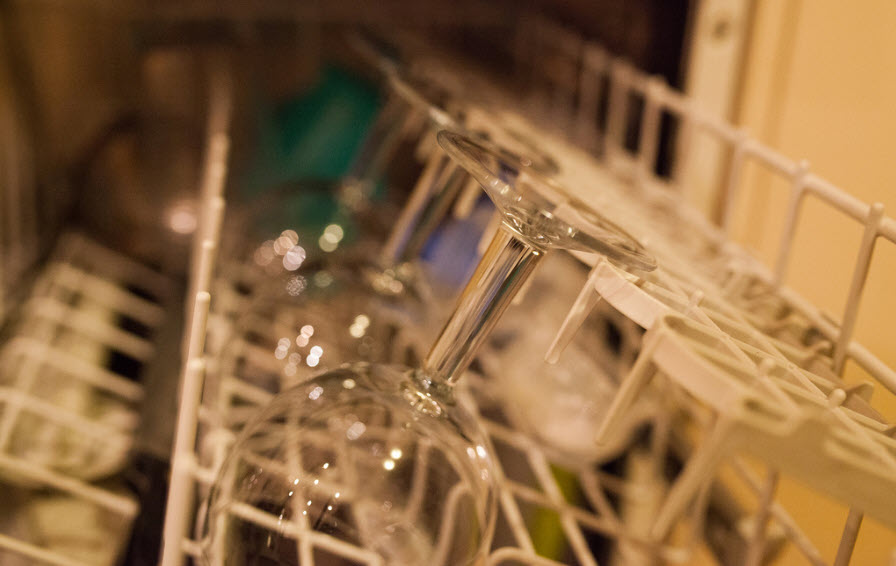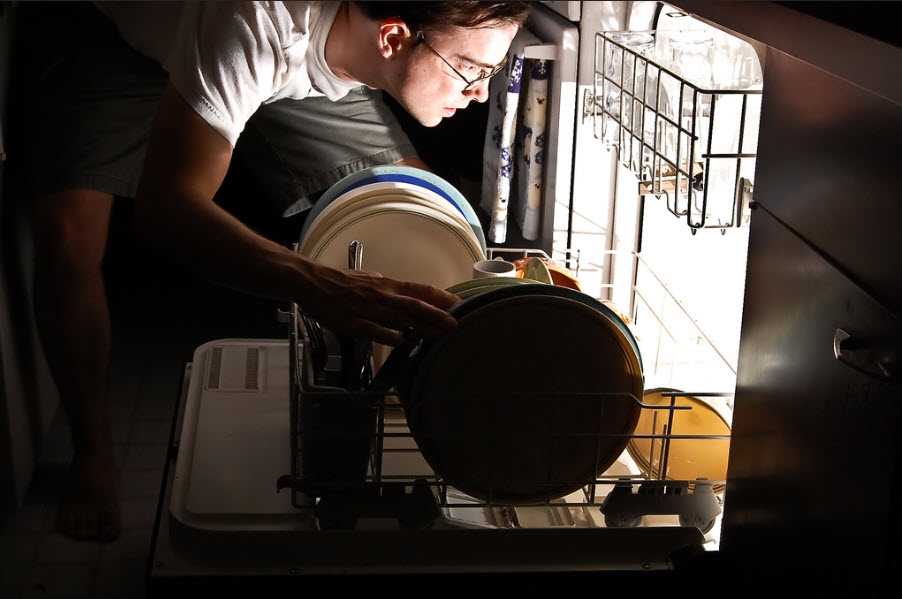
If you are like most people, you may believe that miracle machine which cleans your dishes also cleans itself with every cycle. Unfortunately, dishwashers get gunky too and need to additional cleaning periodically. If not properly maintained, you risk not only suffering with dishes that do not come out fully clean; but also, you can get clogs that may cause your dishwasher to break down and cost you money to repair or replace it. Food particles, grease, and soap scum build up over time and can adversely affect your dishwasher’s performance, causing foul odors. Moreover, if you have hard water, you can also get discoloration and mineral build-up.
Fortunately, keeping your dishwasher clean and running its best is quite simple to do. This is also important because your dishwasher can also be a haven for bacteria and fungi that are simply not good for you, according to a research study in the National Center for Biotechnology Information. Follow these simple steps and you’ll have a dishwasher that’s fresh and clean, just like the pile of dishes it works its magic on.
How Often Should I Clean My Dishwasher?
Once a month tends to be adequate based on the average household’s use. It doesn’t need a deep cleaning that often, and the filter will need to be cleaned based on your household’s loading habits. For instance, if you scrape and rinse your dishes, you will only need to deep clean your filter once per year. If, however, you only scrape your dishes, you may need to clean it up to twice per year. If you neither scrape, nor rinse your dishes, you may be cleaning that filter every month to keep your machine running smoothly, depending on how many loads you run a week. You’ll be able to tell when you need to clean the filter if you see obvious scraps or debris in it, or if your dishes are coming out dirty or gritty after each wash cycle.
Nobody likes having to do a pre-rinse, since the dishwasher is supposed to be doing the work, but it’s important for your filter to effectively protect the pump from becoming clogged by debris and large bits of food. A free-flowing filter cleans and clears the dishwater and keeps food from returning and adhering to the dishes that have already been cleaned. However, only one of the above-mentioned methods for preparing your dishes for the dishwasher is best for your machine, and it may surprise you. This will be discussed later on.
How to do a Thorough Cleaning?
Even a thorough cleaning doesn’t have to be a chore, especially if you have kept your dishwasher clean from month to month. Following these steps will help make your machine run more efficiently and avoid costly issues down the road. Here’s what you will need
- Washcloth
- Grease-cutting dish soap
- Gloves (optional)
- Soft toothbrush
- Toothpicks
- Tools per your owner’s manual, if needed to remove your filter
- Vinegar (no more than 5 percent acetic acid)
- Baking soda (optional)
- 1 to 2 cups of lemon juice (optional)
- 1 package of unflavored lemonade mix (optional)
Now you are ready to begin. Start with a clean, empty dishwasher. Naturally, you don’t want to do any more work than is necessary.
- Remove the bottom rack and silverware rack from the dishwasher. Wash them in warm soapy water, using the toothbrush to reach any corners or crevices as necessary. Rinse and set aside.
- If you can remove the top rack, do the same with it. If not, wipe it down with a damp cloth and get any obvious mess with your toothbrush or cloth.
- Remove the filter if your dishwasher has one. Consult the owner’s manual on how to safely do this. Some machines will have two-part filters, an upper filter and a lower filter. Remove any debris caught in the filter, such as plastic or large pieces of food. Next, gently wash the filter in running water until it is clean. You can use your soft toothbrush to carefully remove anything that’s still stuck on the filter. But remember, filters can be fragile, so you don’t want to scrub too hard. Having to replace one will put your dishwasher out of service for the time it takes to get the new one and will cost you money. Reattach the filter to the dishwasher according to your manual’s instructions.
- Use your toothpicks to clean out the holes in the spinner arm(s) as necessary. Some bottom spinner arms have holes underneath which are designed to spray into the filter to keep it clean. Be sure to clear this hole as well. You may need to remove the spinner arm to do this. Refer to your manual on how to remove it.
- Put a small amount of your grease-cutting dish detergent on a damp cloth and wipe down the gaskets (the seals around the dishwasher door), the door and the interior of the dishwasher. Use the toothbrush to reach any corners or crevices in the door or interior as necessary. The gaskets are common areas where microbes grow, so give them a thorough once over.
- Put the racks back in the dishwasher.
- This next step is a matter of some controversy, which will be explained momentarily. Place 2 cups of white vinegar in a dishwasher safe cup in the bottom rack of the dishwasher and run it without any detergent. The vinegar helps with clogs and bad smells, and will help to dissolve built-up detergent, grease and even mineral deposits in the dishwasher. It kills germs and clears away discoloration and stains. Also, it is non-toxic if not completely washed away during the cycle, unlike bleach.

This all sounds great, right? Unfortunately, vinegar is a relatively strong acid and can break down your dishwasher’s rubber seals (gaskets) and any rubber hoses or nozzles it may have. Imagine if your dishwasher’s seals became damaged and your dishwasher leaked all over your kitchen. What a mess! Worse, the whole thing could breakdown on you from internal damage. It is best to use vinegar, only when your machine really needs a deep cleaning. These would be times like when it had strong foul, odors or was badly stained, like from hard water. Even then, you shouldn’t use a vinegar with more than 5 percent acetic acid in your dishwasher.
- An alternative to vinegar may be using unflavored, unsweetened lemonade mix because of its citric acid content, which performs a lot like vinegar. Be sure your mix contains citric acid before you use it. But be aware, citric acid is a stronger acid than the acetic acid of vinegar!
- Now you can go the extra mile by doing a baking soda cleanse. Scatter a cup of baking soda over the bottom of your dishwasher and either run a short hot cycle or try leaving it overnight before running the dishwasher for even more odor and stain fighting power.
- Or, if you want something to take away the vinegar smell, you could run lemon juice through the machine. Here’s how: put a cup or two of lemon juice in a dishwasher safe cup in the top rack and run the machine through another cycle. This should give you a nice lemon scent. Again, though, you are introducing more acid (citric) into your dishwasher. And, the vinegar smell will fade on its own.
How do I do a Monthly Cleaning?
Do everything on the above list, except taking out the filter and the vinegar cleanse. Clean any large debris from your filter, of course. This should be done on a more regular basis to prevent damage to your dishwasher. You can also clean out any obvious goop with a cloth. Leave your vinegar cleanses for your deep cleaning sessions when you have staining, especially if you have hard water, or if you have stubborn odors. This will help prolong the health of your dishwasher.
Most manufacturers recommend premium dishwasher cleaners for regular monthly use. Also, some premium dishwasher detergent pods contain dishwasher cleaner as a separate component. These don’t take the place of a good wiping down, however. So, on a monthly basis, get at those gaskets and especially those hard to reach places where the wash water doesn’t reach during the cycle.
Do I Really Need to Wash my Dishes Before I Load Them?
Earlier, we mentioned scraping and rinsing dishes verses just scraping, in relation to how often your filter needs cleaning. Well, this also makes a difference in how your dishwasher runs. In fact, it’s best for your dishwasher if you just scrape your dishes before you load them, and here’s why; if you pre-rinse your dishes it obviously wastes water. But contrary to popular thought, it can also result in dirtier dishes because the dishwasher senses that the dishes are cleaner than they really are and doesn’t perform a thorough wash. Also, the recommended detergent requires a specific amount of food residue and grease to work properly. Without this, it just makes excess foam that can cause damage to your machine. Finally, pre-washing wastes water and energy as well as time and effort.
How Often Do Americans Really Use Their Dishwashers?
According to the latest Residential Energy Consumption Survey (RECS) from the U.S. Energy Information Administration (EIA), out of the 118.2 million homes in America from which energy usage data were collected, only 67.4 percent, or 79.7 million homes, had a dishwasher. Of those, 14 percent never used them, while another 11.3 percent used them only once a week. The largest percentage, 22 percent, used their dishwashers two to three times per week. This data was gathered in 2015 and revised in May 2018.
Furthermore, as pointed out by the EIA, compared to washers, dryers, stoves, and even microwaves, the dishwasher is the one of the least used household appliances. And, households with lower incomes are more likely to have dishwashers that are older and not being used. But the Energy Star program of the U.S. Department of Energy and the U.S. Environmental Agency indicates that hand washing your dishes actually uses more water and energy than using a dishwasher.
To make this a little clearer, here are some numbers. According to one study, a single washing by hand uses 40 gallons of water and 3.5 kilowatt hours of electricity to accomplish. However, the same washing in a dishwasher would take four to five gallons of water and only 0.5 to 1.3 kilowatt hours of electricity. So, if it takes 340 kilowatt hours to make a dishwasher, you can easily see that just 10 washings by hand will exceed that amount of energy. In other words, it takes more energy to do 10 loads by hand than it does to manufacture a dishwasher! And let’s not forget all the wasted water, and time and effort on the person’s part, when the machine could have done it more efficiently all around.
So, what’s the bottom line? Scrape your dishes, don’t wash them before loading them in the dishwasher. It could make your dishwasher more effective and even prolong its useful life. Save water and energy by using your dishwasher rather than washing dishes by hand. And, keep your dishwasher at peak performance by keeping up with routine cleaning and doing deep cleanings when necessary or recommended by the manufacturer.
